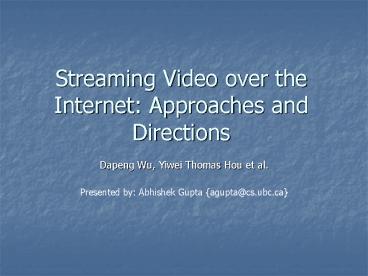Streaming Video over the Internet: Approaches and Directions - PowerPoint PPT Presentation
1 / 19
Title:
Streaming Video over the Internet: Approaches and Directions
Description:
Streaming Video over the Internet: Approaches and Directions Dapeng Wu, Yiwei Thomas Hou et al. Presented by: Abhishek Gupta {agupta_at_cs.ubc.ca} – PowerPoint PPT presentation
Number of Views:596
Avg rating:3.0/5.0
Title: Streaming Video over the Internet: Approaches and Directions
1
Streaming Video over the Internet Approaches and
Directions
- Dapeng Wu, Yiwei Thomas Hou et al.
Presented by Abhishek Gupta agupta_at_cs.ubc.ca
2
Introduction
- Issues in Video Streaming.
- Transmission of Real Time Video typically has
bandwidth and delay requirements. - Current Internet does not offer any QoS
guarantees to streaming video. - For multicast it is difficult to achieve both
efficiency and flexibility.
3
Overview
- Key areas in streaming video.
- Video Compression Scalable and Nonscalable
coding. - Application-layer QoS control.
- Continuous media distribution services.
- Streaming servers.
- Media synchronization mechanisms.
- Protocols for streaming media.
4
Architecture For Streaming Video
5
Video Compression
- Nonscalable Video Coding.
Nonscalable video Encoder
Nonscalable video Encoder
6
Video Compression(contd.)
- Scalable Video Encoding.
Scalable video encoder
Scalable video decoder
7
Application Requirements from Encoder and Decoder
- Bandwidth Rate control.
- Delay - Buffering.
- Loss Multiple description coding.
- Video Cassette recorder like functions.
- Decoding Complexity.
8
Application Layer QoS Control
- Congestion Control
- Rate Control
- Source Based Probe based, Model based (TCP
friendly) - Receiver Based Channel based, Model based.
- Hybrid Rate Control Destination set grouping
and layered multicast scheme. - Rate Shaping Match the rate of a pre-compressed
bitstream to a target rate by use of filters.
9
Application Layer QoS Control (contd.)
- Error Control
- Forward Error Correction (FEC) Channel coding,
Source coding, Joint channel/source coding. - Delay-Constrained Retransmission.
- Error-resilient coding Multiple description
coding. - Error concealment Spatial and Temporal
Interpolation.
10
Continuous Media Distribution Services
- Network filtering.
- Improved video quality.
- Bandwidth efficiency.
- Application level multicast.
- Media bridges-Interconnection of media multicast
networks enabled through application level
peering relationships. - Content replication.
- Caching
- Mirroring
11
Streaming Servers
- Components.
- Communicator Application layer and transport
protocols. - Operating System Real time support for
streaming applications. - Storage System Support for continuous media
storage and retrieval.
12
Streaming Servers (contd.)
- Real Time Operating Systems
- Process management EDF and rate- monotonic
scheduling. - Resource Management - Admission Control, Resource
Allocation. - File Management
13
Streaming Servers (contd.)
- Storage System
- Increase throughput with data stripping.
- Increase capacity with tertiary and hierarchical
storage. - Use SAN, NAS.
- Fault tolerance.
14
Media Synchronization
- Intra-stream synchronization Within a time
dependent data stream. - Inter-stream synchronization Between different
time dependent data streams. - Inter-object synchronization Between time
dependent and time independent data.
15
Protocols for Streaming Video
- Network layer protocols IP.
- Transport protocols TCP, UDP, RTP, RTCP.
- Session control protocols RTSP, SIP.
16
Protocols for Streaming Video (contd.)
Protocol Stacks for Media Streaming
17
Protocols for Streaming Video (contd.)
- Transport Protocols RTP and RTCP.
- RTP
- Time Stamping
- Sequence numbering
- Payload type identification
- Source identification
- RTCP
- QoS Feedback
- Participant information
- Control packets scaling
- Inter-media synchronization
- Minimal session control information.
18
Protocols for Streaming Video (contd.)
- Session control protocols RTSP and SIP
- RTSP
- Support VCR like options
- Provide means for choosing delivery channels and
delivery mechanisms based upon RTP. - Media retrieval
- Adding media to existing session.
- SIP Similar to RTSP but supports user mobility.
19
Future Directions
- Video Compression How about using a combination
of encoding schemes? - Application Level QoS The effectiveness of TCP
like rate control. - Continuous media distribution services A
scalable, cost-effective, efficient and
incremental deployable infrastructure for
continuous media distribution. - Streaming servers VCR like control, Storage
mechanisms, scalability, fault tolerance. - Media synchronization Synchronization in
multicast video while supporting VCR-like
interactive functions. - Protocols Caching, support for pause/resume
operation in caches, security in protocols.































